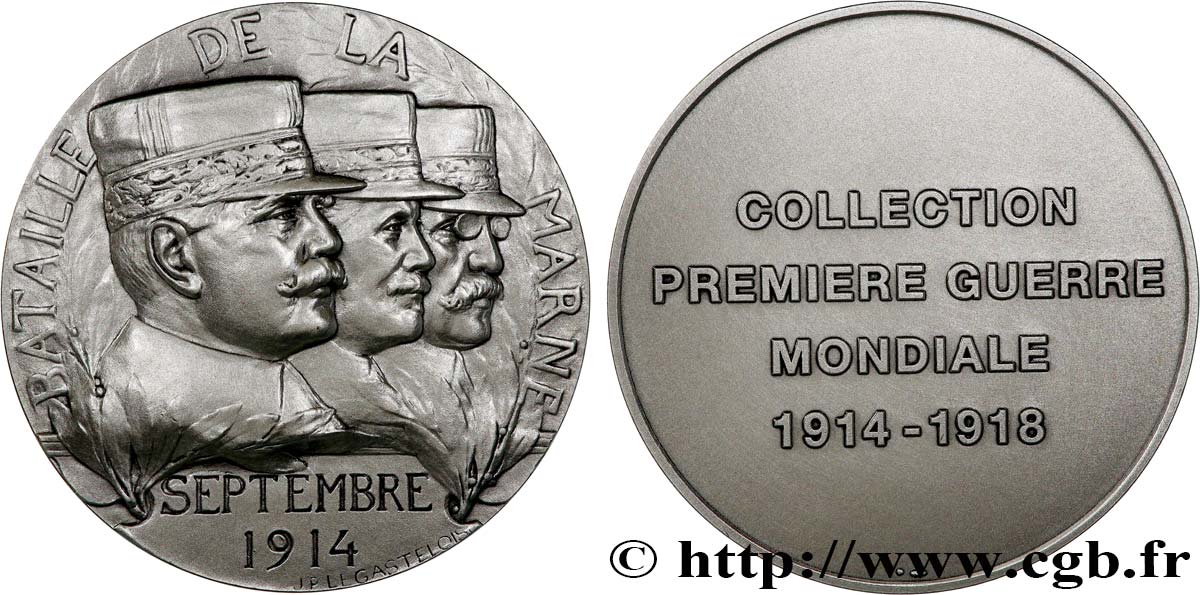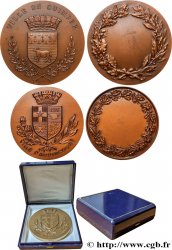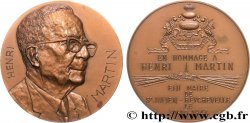fme_702370 - V REPUBLIC Médaille, Bataille de la Marne, Collection Première Guerre MOndiale
75.00 €约 630.00 CNY
数量
加入购物车

种类 Médaille, Bataille de la Marne, Collection Première Guerre MOndiale
日期: n.d.
铸币厂名称/城市 Monnaie de Paris
材质 silver plated bronze
直径 67,5 mm
模子方针 12 h.
硬币制模工 LEGASTELOIS Julien Prosper (1855-1931)
重量 192,8 g.
侧面 lisse
印模 corne d’abondance
关于品相的说明
Légères marques d’usure. Présence de quelques coups et rayures
正面
正面的文字 BATAILLE - DE LA - MARNE // SEPTEMBRE / 1914.
正面的说明书 Buste des trois généraux impliqués dans la bataille de la Marne. Signé : J.P. LEGASTELOIS.
背面
背面的文字 COLLECTION / PREMIERE GUERRE / MONDIALE / 1914-1918.
背面的说明书 Légende en 4 lignes, corne d’abondance double à l’exergue.
评论
Cette médaille commémore les 2 batailles de la Marne avec les trois portraits des généraux J. Joffre, M.-J. Maunoury et J. Gallieni.
La première bataille de la Marne, souvent identifiée comme « la bataille de la Marne » a eu lieu du 5 septembre 1914 au 12 septembre 1914 entre d'une part l'armée allemande et d'autre part l'armée française et le corps expéditionnaire britannique. Cette bataille doit être distinguée de la seconde bataille de la Marne, qui se déroula en juillet 1918.
Les combats se déroulèrent le long d'un arc-de-cercle de 225 km à travers la Brie, la Champagne et l'Argonne, limités à l'ouest par le camp retranché de Paris et à l'est par la place fortifiée de Verdun. Ce champ de bataille est subdivisé en plusieurs batailles plus restreintes : à l'ouest les batailles de l'Ourcq et des deux Morins, au centre les batailles des marais de Saint-Gond et de Vitry, et à l'est la bataille de Revigny.
Au cours de cette bataille décisive, les troupes franco-britanniques arrêtent puis repoussent les Allemands, mettant ainsi en échec le plan Schlieffen (revu par Moltke) qui prévoyait l'invasion rapide de la France en passant par la Belgique, pour éviter les fortifications françaises de l'Est et ensuite se reporter contre la Russie. La retraite allemande se termine sur la rive droite de l'Aisne dès le 14 septembre, ce qui déclenche la bataille de l'Aisne..
This medal commemorates the two battles of the Marne with the three portraits of generals J. Joffre, M. -J. Maunoury and J. Gallieni.
The First Battle of the Marne, often referred to as \\\"The Battle of the Marne,\\\" took place from 5 September 1914 to 12 September 1914 between the German Army and the French Army and the British Expeditionary Force.. This battle must be distinguished from the Second Battle of the Marne, which took place in July 1918.
The fighting took place along a 225 km arc through Brie, Champagne and Argonne, limited to the west by the entrenched camp of Paris and to the east by the fortified town of Verdun.. This battlefield is subdivided into several smaller battles: to the west the battles of the Ourcq and the two Morins, in the center the battles of the marshes of Saint-Gond and Vitry, and to the east the battle of Revigny.
During this decisive battle, the Franco-British troops stopped and then pushed back the Germans, thus thwarting the Schlieffen Plan (revised by Moltke) which planned the rapid invasion of France via Belgium, to avoid the French fortifications in the East and then turn against Russia.. The German retreat ended on the right bank of the Aisne on September 14, triggering the Battle of the Aisne..
La première bataille de la Marne, souvent identifiée comme « la bataille de la Marne » a eu lieu du 5 septembre 1914 au 12 septembre 1914 entre d'une part l'armée allemande et d'autre part l'armée française et le corps expéditionnaire britannique. Cette bataille doit être distinguée de la seconde bataille de la Marne, qui se déroula en juillet 1918.
Les combats se déroulèrent le long d'un arc-de-cercle de 225 km à travers la Brie, la Champagne et l'Argonne, limités à l'ouest par le camp retranché de Paris et à l'est par la place fortifiée de Verdun. Ce champ de bataille est subdivisé en plusieurs batailles plus restreintes : à l'ouest les batailles de l'Ourcq et des deux Morins, au centre les batailles des marais de Saint-Gond et de Vitry, et à l'est la bataille de Revigny.
Au cours de cette bataille décisive, les troupes franco-britanniques arrêtent puis repoussent les Allemands, mettant ainsi en échec le plan Schlieffen (revu par Moltke) qui prévoyait l'invasion rapide de la France en passant par la Belgique, pour éviter les fortifications françaises de l'Est et ensuite se reporter contre la Russie. La retraite allemande se termine sur la rive droite de l'Aisne dès le 14 septembre, ce qui déclenche la bataille de l'Aisne..
This medal commemorates the two battles of the Marne with the three portraits of generals J. Joffre, M. -J. Maunoury and J. Gallieni.
The First Battle of the Marne, often referred to as \\\"The Battle of the Marne,\\\" took place from 5 September 1914 to 12 September 1914 between the German Army and the French Army and the British Expeditionary Force.. This battle must be distinguished from the Second Battle of the Marne, which took place in July 1918.
The fighting took place along a 225 km arc through Brie, Champagne and Argonne, limited to the west by the entrenched camp of Paris and to the east by the fortified town of Verdun.. This battlefield is subdivided into several smaller battles: to the west the battles of the Ourcq and the two Morins, in the center the battles of the marshes of Saint-Gond and Vitry, and to the east the battle of Revigny.
During this decisive battle, the Franco-British troops stopped and then pushed back the Germans, thus thwarting the Schlieffen Plan (revised by Moltke) which planned the rapid invasion of France via Belgium, to avoid the French fortifications in the East and then turn against Russia.. The German retreat ended on the right bank of the Aisne on September 14, triggering the Battle of the Aisne..








 对产品描述纠错
对产品描述纠错 打印
打印 分享我的选择
分享我的选择 提问
提问 Consign / sell
Consign / sell
 产品介绍
产品介绍









